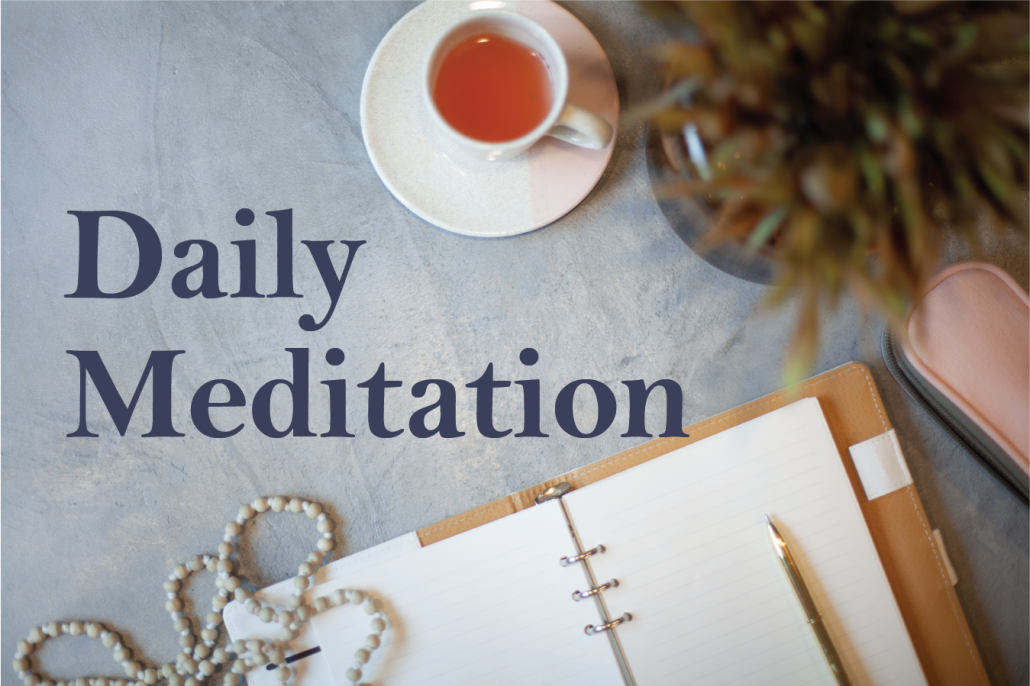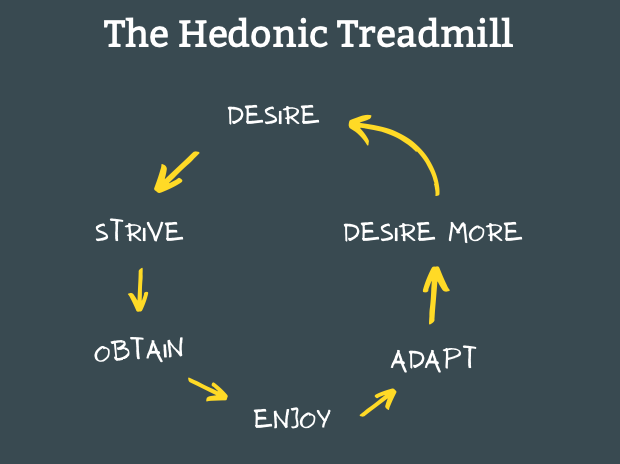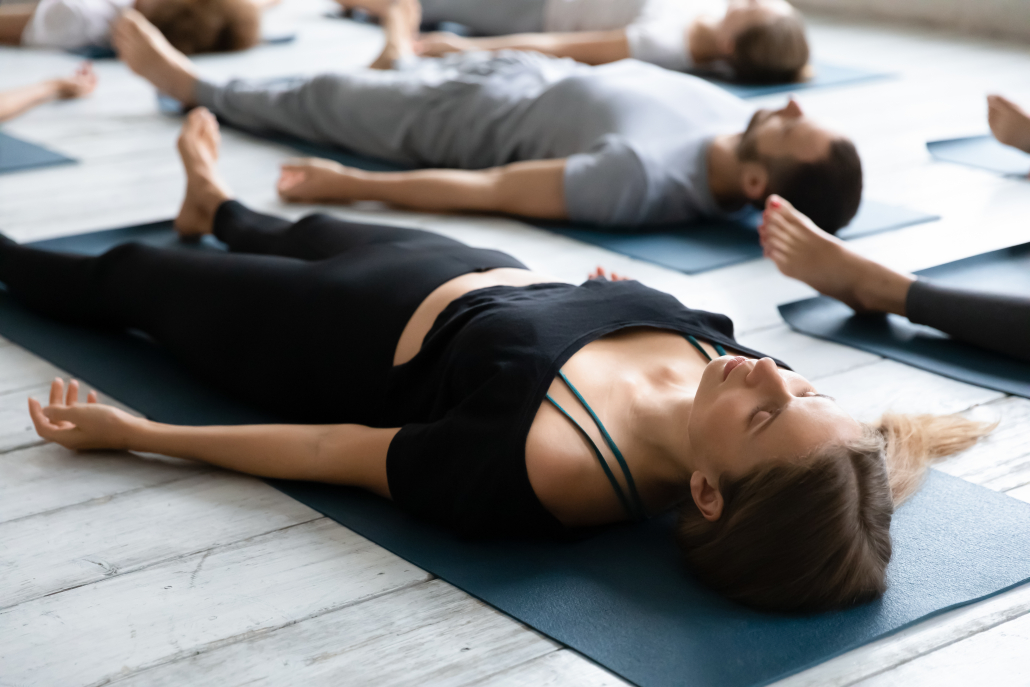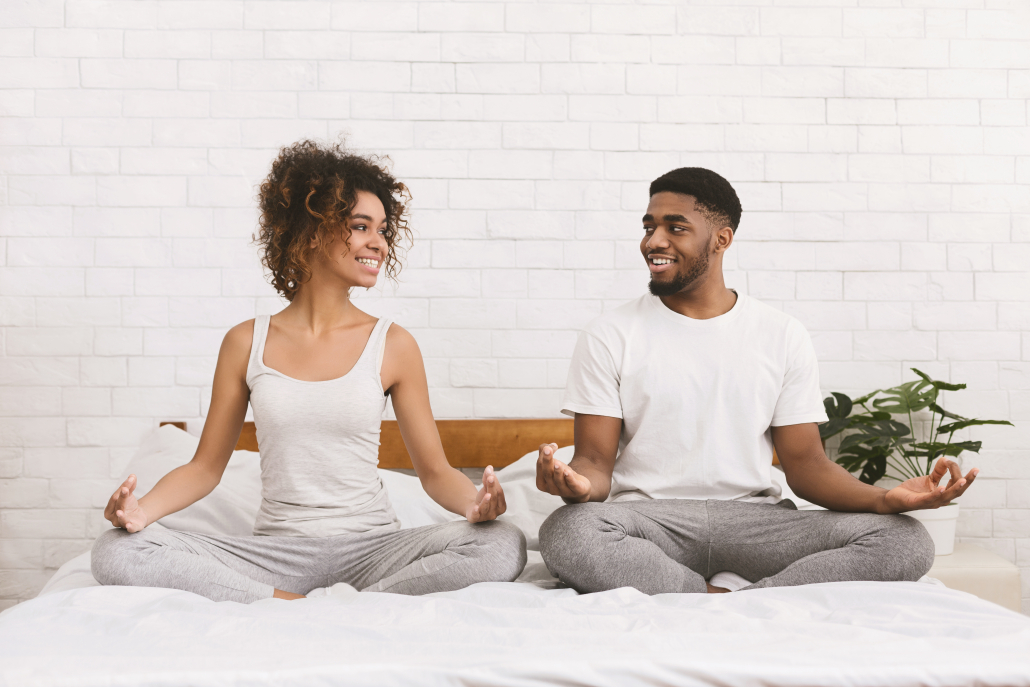We include products in articles we think are useful for our readers. If you buy products or services through links on our website, we may earn a small commission.
7 Strategies to Make Daily Meditation a Habit

Table of Contents
To get the proven benefits of meditation it’s important to make meditation a daily practice–that’s where these 7 strategies to make daily meditation a habit come in.
Master Shantideva, Buddhist Monk (800AD), said, “The person whose mind is distracted lives between the fangs of mental afflictions.”
Today, we call these mental afflictions, “anxiety”, “depression” and “stress.” They’re part of our fast-paced, hyper-connected lives. And they’re exacerbated by events like the global pandemic.
Now millions of people practice meditation as a way to cope with their daily stressors. And for good reason. A 2013 analysis of over 200 studies confirmed that mindfulness meditation is “especially effective for reducing anxiety, depression, and stress.”
But these effects were seen after daily practice for 8-12 weeks. What this tells us is that meditation isn’t a pill. It’s a process, and its effects accumulate over time. These 6 strategies will help you stay in the proverbial saddle.
What is Meditation?
Daily meditation practices are mind and body techniques that you use to bring about a heightened state of awareness and focused attention. These states are aimed at changing consciousness in ways that make you less reactive to stressors, more in-touch with your body and sensations, and more compassionate towards yourself and others.
Meditation has been shown to re-wire the way your brain processes your experiences, literally transforming your reality.
Benefits of Daily Meditation
This process of mental and emotional rewiring brings about many benefits including:
- Eases muscle and joint tension and increases capacity to accept criticism from others
- Lowers anxiety, stress, depression, and pain
- Reduces blood pressure and heart rate
- Benefits sleep, reduces tendencies toward violence and nail biting, builds hope, and lessens guilt
- Helps treat Alzheimer’s symptoms and improves cognition
- Cultivates higher emotional intelligence, lessens perceived stress, and improves mental health
Why Meditate Daily?
Meditation is like a muscle, the more often you work it, the stronger it will get. That’s why for many people it’s important to meditate daily.
However, meditation is not necessarily about results. Confused? Let us explain; the benefits of meditation come from the process of meditating.
This process depends on your intent and willingness to focus your attention on the meditative object–often your breath, sounds in your environment, or sensations in your body.
Meditation isn’t just something you check off your daily to-do list.
If you meditate only 3 times a week but with a clear intention and strong focus, you can have a deeper more beneficial experience than if you’re just waiting for the alarm to go off after twenty minutes of watching your mind wander every day.
But wait? Isn’t it true that there’s no right way to meditate?
Sure, there’s no single practice that’s right for everyone. But there are ways of orienting to any practice you chose that will make it more effective.
And like anything worth doing, the more clear your intention, and the more often you practice it, the better it will be.
How to Establish a Daily Meditation Routine
1.Establish an intention
Why do you want a daily meditation? Once you have an answer, try asking yourself, “Why?” six more times until you reach your big picture goal.
In yoga, your big picture goal is called your Sankalpa. Sankalpa is Sanskrit for a single-pointed promise to focus the mind on a specific goal. This promise is a tool to build willpower and to concentrate and unify your mind and body.
There will be days when you just don’t feel like sitting on the cushion. Having a Sankalpa to come back to will provide clear motivation for continuing your practice.
2. Start small
A 2009 study looking at how people form habits found that simpler actions become habitual more quickly. Applying this to mediation means starting off with shorter sits.
Try meditating from three to five minutes and work up from there. Add five minutes each week until you’re up to 20-30 minutes per session.
And if you can’t get there that’s fine too. A 2011 Harvard study looking at the effects of meditation on the brain found significant changes after a combined 27 minutes of meditation per day. So if it’s hard to take longer than 15 minutes out of your day at one time, you can split up your sessions to around 13 minutes each.
Beginners also struggle with the physical demands of sitting. But you don’t have to turn sit in lotus to get the benefits of meditation. There’s nothing more of less spiritual about having your legs folded. In the ancient world, it was viewed simply as a posture that allowed people to sit undisturbed for the longest period of time.
Though lotus posture may be something you want to work up to, you can also chose to sitting in a chair, lying down, or even while walking.
Again, starting with shorter time intervals allows your body (and mind) to adjust to the practice without causing too much frustration.
As you meet your beginning goals (however small), your self-esteem increases. Increased self-esteem has been shown to promote pursuing future (or bigger) goals.
So if you set a goal to meditate for three minutes and achieve that goal, you’ll encourage yourself to set goals to meditate for longer, growing your capacity to focus your mind over time.
3. Set a time and place
Numerous studies have shown that habits are actions triggered automatically in response to cues in our environment.
When it comes to daily meditation, making a consistent time and space can trigger your mind and body to enter meditative states more quickly and deeply.
In essence, you are creating a rhythm. Over time, the selected time of day becomes associated with the sensations of meditating, and you begin to feel a regular “call” to your practice. It’s like putting motivation on autopilot.
The environment also helps to automate your motivation, and this can free mental capacity for the actual process of meditation.
A conducive space to meditate can include your favorite fragrance or incense, pictures of your teachers or loved ones, and pillows, cushions, or blankets that you use only for meditation.
Again there’s nothing inherently spiritual about the traditional accoutrement of meditation–pillows, incense, bells, and monks’ robes etc. They all serve the function of triggered the mind and body into seeing and experiencing the world in a certain way.
So think about the equivalent objects that you associate with peace, presence, and insight.
4. Practice with joy
A 2020 study found that the average person has over 6,000 thoughts per day. So it’s no surprise that your mind will get distracted during your meditation.
In the West, we have a romanticized idea that meditation means not thinking. Good luck with that one!
Meditation isn’t about not thinking and never has been. It’s about where you focus your attention.
This means noticing, without blame or shame, when your attention inevitably becomes lost in thoughts, and then gently and joyfully bringing it back to the object of focus. Again, and again, and again.
The Buddhists call this concept “intelligent regret”. If your mind wanders, instead of immediately returning your focus to your breath, infuse positivity into your practice by taking a moment to congratulate your mind for being aware and returning to the breath.
An advanced meditation mudra (or position) that also helps spark joy is to slightly curl the edges of your lips up toward the center of your eyes to form a subtle smile. Think of it as becoming a spiritual Mona Lisa. You can see this subtle smile is depicted on many statues of the Buddha in meditation.
You may not show up to your cushion blissfully every single day, but if you can intentionally bring joy to your practice, you’ll set yourself up for success.
5. Reward yourself
In psychology, rewarding yourself after completing the desired behavior is called “positive reinforcement”. When this reward consistently occurs after the desired behavior (like meditating), our brains restructure themselves on a neurological level to better complete that behavior and gain the reward.
This ability of our minds to reshape themselves is called neuroplasticity. Numerous studies have looked at how this ability plays out in daily life. One study showed that managers who were provided with immediate reinforcement after training showed improved consideration and integration skills, and reduced absenteeism at work.
So it figures that this same process will also reduce absenteeism on the meditation mat!
Some examples of immediate positive reinforcement after meditating could be eating some fresh low-carb berries, looking in the mirror and noticing how calm you appear compared to before meditating, and logging one more day in your daily meditation tracker.
6. Track your progress
A 2011 study showed that many people who meditate experience doubts about the efficacy of engaging in it as an activity. Yet hundreds of studies routinely show that for the vast majority of people, meditation has powerful positive impacts on the mind, body, emotions, and relationships.
So where does the doubt come from?
One way to understand it is from the perspective of “hedonic adaptation”, also known as the “hedonic treadmill.” This describes the tendency that nearly all people have of quickly returning to a relatively stable and familiar level of happiness (or suffering) despite major positive changes in their lives.

Image from ismantledmind.com
Though a natural part of being human, doubting that change is real can lead to giving up. One way to track efficacy is by keeping a log or journal and reviewing old entries to see how far you’ve come.
Helpful items to note from your meditations are the time, life events and feelings about them before meditating, persistent distractions (if any), and any questions or realizations that resulted from your practice.
Having these details handy can help you also become more aware of how your thoughts shape your reality, so you get two for one benefits with this strategy!
7. Stack the Self-Care Routines
If a daily habit of meditation is your only self-care routine, that places a lot of pressure on it. If you miss it a couple of times if can be easy to fall off the self-care bandwagon.
But when daily meditation is part of a group of healthy routines including low-carb or a keto diet, yoga, walking, swimming, and breathing, you build a synergy of supporting activities and a momentum that will propel you through more distracting and challenging periods.
When it comes to self-care routines, there’s strength in numbers
The Outlook on Making Daily Meditation a Habit
Meditation is an ancient and accessible tool for soothing the mind and improving your mental, physical, and emotional health.
There are many resources out there to help you get started meditating. But turning something you’ve tried a few times into a daily habit requires a different set of skills.
Setting your intention, sticking to a set time and place, bringing joy to even the most annoying parts of meditating (i.e. your own mind), rewarding yourself for showing up, and tracking your progress over time are all proven strategies to help you establish a lifelong meditation practice.
The most important thing to remember is not to expect this to happen overnight. Habits take time to form. Recent research found that it takes, on average, around 66 days after the first daily performance, to form a habit.
So here’s to day 1!
















